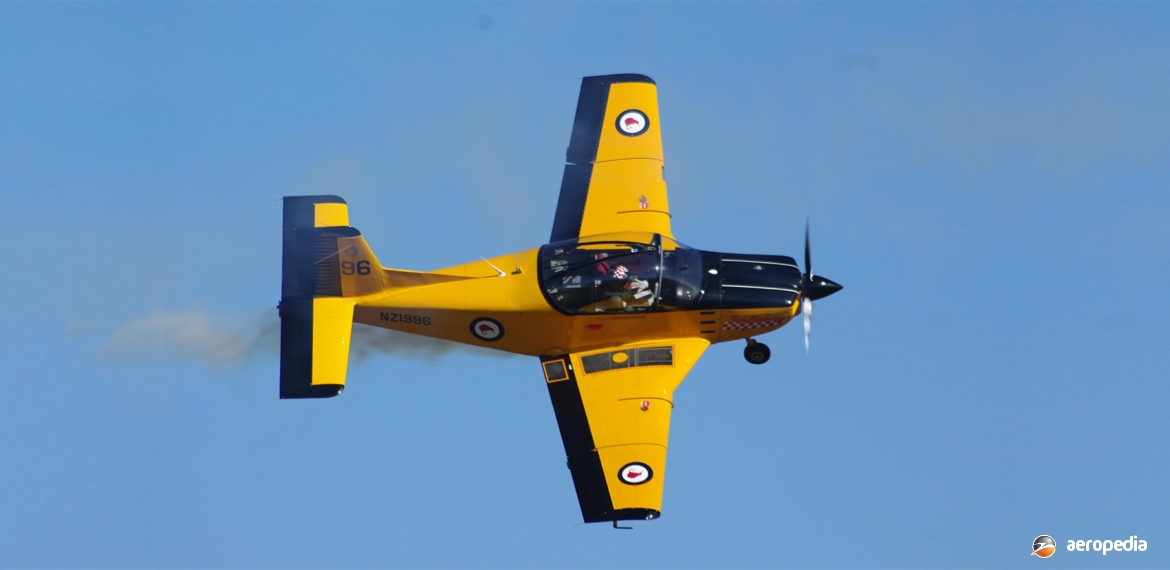Photograph:
PAC CT-4E Airtrainer NZ1996 at Omaka, New Zealand in April 2009 (David C Eyre)
Country of origin:
New Zealand
Description:
Two-seat single-engine low-wing training monoplane
Power Plant:
One 224 kw (300 hp) Textron Lycoming AEIO-540-L1E5 six-cylinder horizontally- opposed air-cooled engine
Specifications:
- Wingspan 7.92 m (26 ft)
- Length 7.16 m (23 ft 4¾ in)
- Height 2.59 m (8 ft 6 in)
- area 11.98 m² (129 sq ft)
- Max speed 388 km/h (241 mph)
- Cruising speed 278 km/h (173 mph)
- Stalling speed flaps down 83 km/h (52 mph)
- Stalling speed flaps up 111 km/h (69 mph)
- Max manoeuvring speed 274 km/h (170 mph)
- Rate of climb 558 m/min (1,830 ft/min
- Service ceiling 5,547 m (18,200 ft)
- Range 836 km (519 miles)
- Take-off run 182 m (600 ft)
- Landing run 169 m (553 m)
- Empty weight 807 kg (1,780 lb)
- Loaded weight 1,180 kg (2,600 lb)
History:
The CT-4E is a two-seat (with a third seat optional) low-wing all-metal single-engine monoplane with a fixed tricycle undercarriage, a Lycoming AEIO-540 fuel injected piston engine certified for inverted flight, driving a Hartzell three-blade constant speed propeller. Designed for the training market, it has a fatigue life of up to 14,000 hours, has dual engine and propeller control levers, and has dual control columns. Seating is designed for back-pack parachutes, and the canopy has been designed so pilots can use helmets. It has hydraulically operated disc wheel brakes, a parking brake system, conventional ailerons, rudder and elevator connected by push-rods and cables, and a 28 volt DC electrical system. Fuel is gravity fed from two integral wing tanks into a common collector tank.
The CT-4E was developed to meet the requirements of training operators, and production began in 1997. This model was successful, with examples being sold to the Royal Thailand Air Force (c/ns 214 and 215, and 233 to 240), these machines having a third seat, and the RNZAF, obtaining a fleet of 13 aircraft to replace its earlier fleet of CT-4s, the latter being sold to civil operators. The RNZAF aircraft were owned by Aeromotive, were leased to the RNZAF, and were painted overall yellow with military serials. The first examples of this fleet were received in August 1998 and seven (NZ1985 to NZ1991 – c/ns in the range from 200 to 212) were delivered to the Pilot Training Squadron at Ohakea. The type, like the earlier models, was used by the official RNZAF air display team.
Eventually the Thai Air Force aircraft were retired and sold to private operators; one example was exported to Australia and placed on the Australian civil aircraft register as VH-CTZ (c/n 216); and two others took up duties alongside three Aero L-39 Albatros with Combat Flights from Camden, NSW, becoming VH-NMX (c/n 232) and VH-NMY (c/n 231).
The type is fully aerobatic and the fuselage is all-metal stressed-skin construction with a fibreglass cowling. The wing is of single-spar light alloy stressed-skin structure with fiberglass wingtips, which are detachable to permit optional wingtip fuel tanks to be fitted. Fuel capacity is 204.5 litres (45 Imp gals) but this could be increased, with the fitting of wingtip tanks, by 77 litres (17 Imp gals). A variant was entered in a competition to meet the requirements for a trainer for the USAF but was not successful.
Following the order and receipt of the first examples of the Beech T-6C Texan II into RNZAF service the 12 remaining CT-4Es were returned to Aeromotive Ltd at Hamilton and placed back on the NZ Civil Aircraft Register, taking up their former registrations, becoming ZK-PTA (c/n 200); ZK-PTB (c/n 201); ZK-PTC (c/n 202); ZK-PTD (c/n 203); ZK-PTG (c/n 206); ZK-PTH (c/n 207); ZK-PTI (c/n 208); ZK-PTJ (c/n 209); ZK-PTK (c/n 210); ZK-PTL (c/n 211); ZK-PTM (c/n 212); and ZK-PTV (c/n 204), the latter formerly being ZK-PTE. One has been placed on display at the RNZAF Museum at Wigram.

